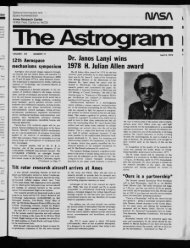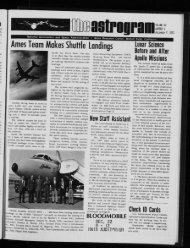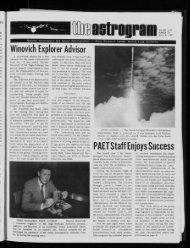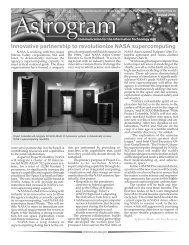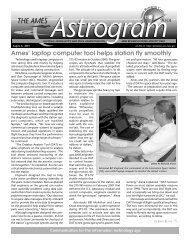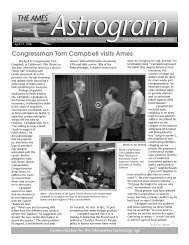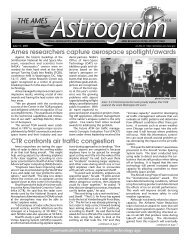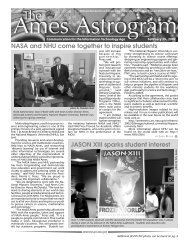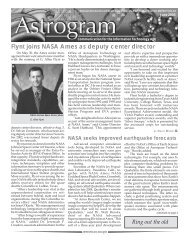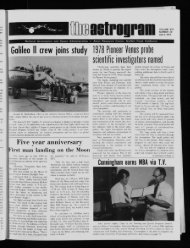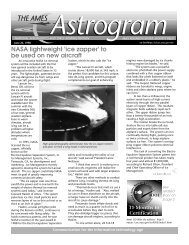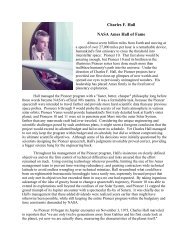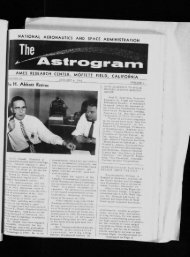1976 July-September - NASA Ames History Office
1976 July-September - NASA Ames History Office
1976 July-September - NASA Ames History Office
You also want an ePaper? Increase the reach of your titles
YUMPU automatically turns print PDFs into web optimized ePapers that Google loves.
NatJonat Aeronau1n,a:P, atlve Inter-city<br />
Iransponation are revi~ing interest in lighter-than-air<br />
~d~icles Milltar3, planners, too. are taking another<br />
I,Jok at the use ol airship-, for ~,on’~e miM.ary mJssums<br />
!i~r wh[cb they stein to be particularl.~ ~ell adapted<br />
these ne,,~ civil and militar!, applications wdl<br />
require ~ellicl~: conccpp, which do not resemble The<br />
atrshJp> ol lhc past instead the) ma:, con]brae e~ements<br />
ot both hea~icr-than-air ~.ehicle’, iairptan¢:~<br />
:Jlld lightcr-lhan-air vehicles lai;shlpsl<br />
Anl¢~ is currently studs.ms two lightct-lhan+aiT<br />
u~nccpts lot ci~d u~c through a contract v. Jlb<br />
~;oudycar Aerospace (orp ¯ Akron, Ohto<br />
rhc fiTs1 ol lhese ,_on,opts is being Mudled fl~r iIs<br />
polenlial as ~aTt Oi a ILature short+haul transportatmn<br />
s~,stcnl [}It’ xehicl¢ woLdd be u~?d a> a<br />
~)eder airliner and ~’,otJld be t~(J m i2()0 H llongand<br />
~arr~, gU’ passengcr~, Although thts is about tbc ~qze<br />
+ta (;ood},¢ar bhlnp, its tarS, ~llg CallaCll ~, Ls three<br />
[In}k’S [IS ~rcdt<br />
It uould c~u]se al I {~(1 knots I 1 2{, ll~iS h I and be<br />
rble to }and and take oH verlicall~, Pow¢~ wotJld bc<br />
rurnisi~ed b} four turboprop engines dmmg large<br />
Iw¢)p-IOtor~ which could be filled up~ard tot<br />
*a keofl and landing<br />
[’hi’, concept IS partJcutarl~ atlracti~e today<br />
becau~t, of its potential for reduction ol nop, c and<br />
Ibe othc~ concept under stud:, is 1or :l ~ebicle to<br />
t=an:,port large, hear) payloads met comparathel~.<br />
short dislances This concept, called a heavy lifter,<br />
,mlhines It’atures ol large dirigible:, and helicoptert}pe<br />
rotor systems to provide ]ii:lmg capacily lar<br />
heyond lhat of either vehicle lype alone. Dirigible<br />
buoyancy, is used to lift the ~ehlc[e enlpt} weighl.<br />
L’aving the Iotal lilting capacily ol the rotor system<br />
It+ + Idt and st~pport lhe payload Vehicles capable ol<br />
lilting payloads of’up Io 225.000 kg (250 tonsl ha~e<br />
heen considered.<br />
A smaller proof-of-concept version of a heavv<br />
hfter capable ol lifting 07,500 kg (75 Ionsl Is unde’r<br />
dudy -[his ve~,.:~lOll would use (our h¢licopte~ rotor<br />
systems supporled by a dirigible hull ol<br />
~5.000 cubic reelers 125 million cubic I>et~<br />
displacement.<br />
Of qle two vehicles, the heavy lifter appears the<br />
mosl likely for immediate application, lransporling<br />
JlC&vy power gcneralillg eqnipnlenl or othel ot~lsi/e,<br />
heavy indnstrial equipment, particularly when file<br />
destination is a remote area not ~,rved by other<br />
heavy transporlalion systems.<br />
]here are also several potential military missions<br />
lot tb~ heavy liltcr. Principal among these Js lor<br />
transporting sbJp cargos over tile beach to shore<br />
points<br />
<strong>NASA</strong>. in coniunction with thv Nay,, is also<br />
studying other militaR,’ uses lur conventional airships<br />
The missions being considered are ti~o~+ which<br />
use i’bt’ great CndLlrance capability, ot a]rq/ip~ h~<br />
advantage such as antisubmarine wariare iilld St’a<br />
control<br />
Stlbslitulmg inert helium ga+ h>r the vo~,dile<br />
hydrogun u~d in the German atr.;hips ol the 20s and<br />
3Os. and beneBtting from our increased engineering<br />
knowledge and better tradeR, landing ol weather<br />
phenomena, a modem airship woldd be an<br />
extremel) saie ~ehicle to 1]}<br />
lhe N~.SA spon~)red studies wilt he completed<br />
this summer It is ant~clpated thai a number ol ne~<br />
Icchnolog:~ approaches al~d theil benefit, wdl be<br />
defined There will al~o tikeb be a number ot area~<br />
17ceding re~’arch and developnlent v, hich wiB he<br />
benei]~ial to modem airship concepts ~hich c;ulld<br />
be ptm~ued d] the tut:*re<br />
August 26, <strong>1976</strong><br />
MASA-ASEE design study:<br />
Project Orion<br />
Ever) summer for the past eight years. <strong>Ames</strong><br />
Research (enter and Stanford University have<br />
iointl) coordinated <strong>NASA</strong>-ASEE design studies on<br />
x~ide variet), ol t¢~pics. This ~ummer, the stud~ has<br />
considered the design of systems which would<br />
enable mankind to address a fundamental and as yet<br />
unanswered question: "’Are [flanetary systems a<br />
.omnlon occurrence in tile Galax). or is the solar<br />
s),,tem unlqk!e: P" The project director ",’,’as Daqd<br />
Black oi <strong>Ames</strong>" Theoretical and Planetary Studies<br />
Branch.<br />
The eftort~ o1 Ibis summer were directed pr><br />
marib, toward the design ot an ullimate telescope<br />
lor the purpose ol a,tmmetric detection of p~anets<br />
~.stron~:,lr}, i> that branclt ol astronom? concerned<br />
v.~th precise detcrmmal~ons or" lb¢ position of stars<br />
II a siar ha~ a planetar3 companion tl~e apparent<br />
rnc~tion o~ the slat acres., the sk.~ wd] undergo a<br />
~ruMh bLI[ In principle, detectab~e wobble. Some<br />
tooling !or the magnitude of the task can be had<br />
tr’.)nl tbc iollowmg example De~e



